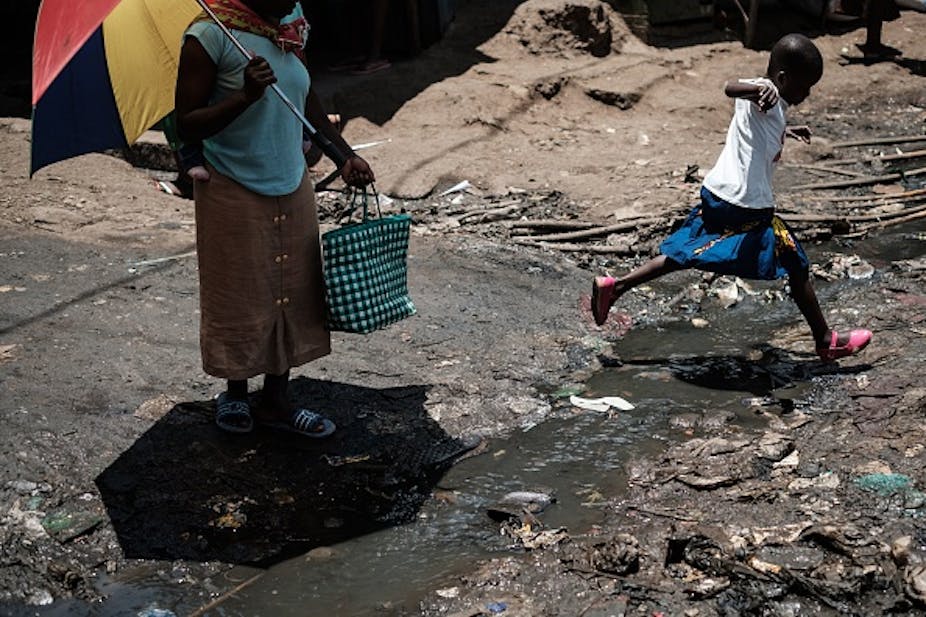Imagine you are miles from the nearest restroom, and nature’s call is urgent – a situation that might raise a mild panic during a hike or at a music festival. Now, picture that same scenario, not as a one-off inconvenience, but as a daily reality. This is the case for about half a billion people globally.
In African countries, the issue of open defecation often goes unaddressed by society and policymakers despite its negative impact on health, economic development, dignity and the environment.
Led from Queen’s University Belfast, a team of multidisciplinary researchers aimed to evaluate how prevalent the practice is in African countries and which social factors are driving it. We also aimed to establish which communities were in most urgent need of interventions.
We used demographic and health surveys, alongside World Bank data. In a recent paper we set out our findings.
Our main ones were that in Nigeria, Ethiopia, Niger, the Democratic Republic of Congo, Burkina Faso and Chad, a large number of people engaged in open defecation.
We found that as few as ten countries could account for 247 million Africans defecating in the open by 2030 if critical and emergency actions are not taken.
The biggest driver is lack of access to proper sanitation facilities. The poorest individuals, particularly in rural areas, are more likely to resort to open defecation than people in urban areas. In regions with the most critical need, the poorest are 43 times more likely than the wealthy to resort to open toileting.
We recommend tackling poverty, and intervening in regions and communities that urgently need improved sanitation infrastructure and programmes. West Africa needs special attention since many of its communities are in the critical category.
A systematic approach
Sanitation has far-reaching implications for food safety. Contaminated water sources and unsanitary conditions can spread waterborne diseases, which can contaminate food and put millions at risk. Addressing open defecation is a step in ensuring the safety and hygiene of the food chain.
The link between poor sanitation and health is well documented. But our study casts this relationship in a new, alarming light: the likely role of open defecation in antimicrobial resistance.
Antimicrobial resistance is the ability of microbes, such as bacteria, viruses and fungi, to resist the effects of medications that were once used effectively against them. It is a looming crisis, threatening to make antibiotics ineffective. Common infections could once again become deadly.
Our research suggests a probable link between open defecation and antimicrobial resistance. When people defecate outdoors, resistant bacteria from human waste can contaminate water and food. This often leads to faecal-oral diseases and urinary tract infections.
Read more: Gutter to gut: How antimicrobial-resistant microbes journey from environment to humans
However, there is a need for more research to clarify the relationship, its implications and prevention. A clear recommendation from our research is that data about antimicrobial resistance should be integrated into health surveys.
While the full breadth of the study’s findings is huge, its conclusions are clear: open defecation is a challenge in Africa that requires actions. Our research doesn’t just ring the alarm bell; it provides a blueprint for change, identifying specific regions where the practice is most prevalent and where interventions could have the greatest impact.
What needs to be done
Addressing open defecation across a continent as vast and diverse as Africa is no small feat. We made a number of recommendations in the study.
A pragmatic three-tier priority system
This will categorise regions based on the urgency of need for intervention: critical, high, and medium. Regions marked as critical are those with the highest prevalence of open defecation (more than 80% of the population) and the least access to sanitation facilities. These areas need immediate attention with the deployment of resources and sanitation infrastructure. The high priority regions have some access to sanitation. Here, the strategy is a combination of infrastructure development and community education. For medium priority areas (40%-59%), where some sanitation infrastructure may exist, the focus should be on sustainable practices, behavioural change and maintenance of existing facilities.
The system above is just to cut the high rates and inequalities among communities in a country. There is also a lot to do in communities with an open defecation rate of less than 40%. The goal is to reinforce positive behaviour and ensure facilities are maintained and improved.
Policy support, such as incentives for building private toilets or community sanitation blocks, may also help. This tiered strategy hinges on continuous assessment and reallocation of resources. Interventions should respond to the changing landscape as regions improve or decline.
Support sanitation projects and policies
Advocacy is important to increase awareness and donations to organisations that build toilets and provide sanitation programmes in affected areas.
Educate and spread awareness
Learning about the cultural and socio-economic factors that contribute to this practice must be encouraged and the knowledge shared with others. Campaigns that focus on the importance of sanitation for health and the environment are key.
Encourage sustainable sanitation practices
This includes using toilets properly, not littering, and understanding local challenges. The use of compostable toilets and other sustainable waste management practices where traditional toilets are not feasible must be encouraged.
Foster global partnerships for sanitation
Global partnerships can amplify efforts to end open defecation. Collaborations between governments, NGOs, private sector stakeholders and international organisations must be encouraged. Pooling resources and sharing knowledge can lead to more effective and sustainable solutions.

